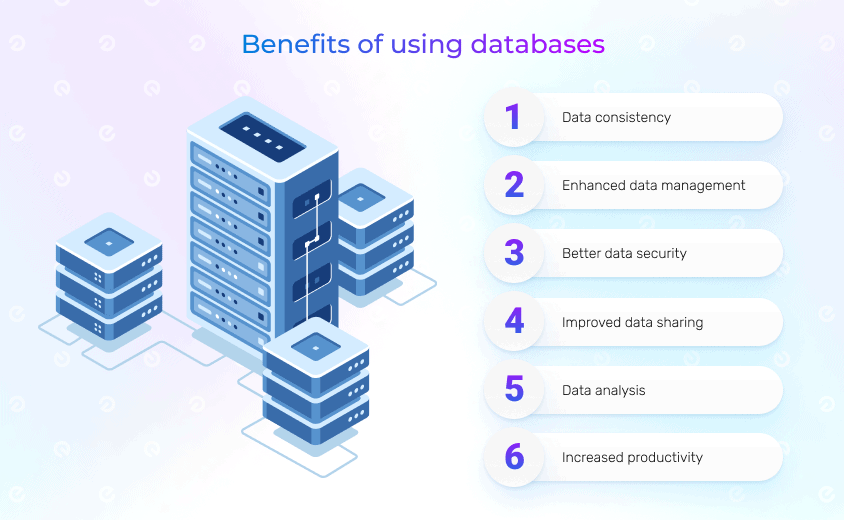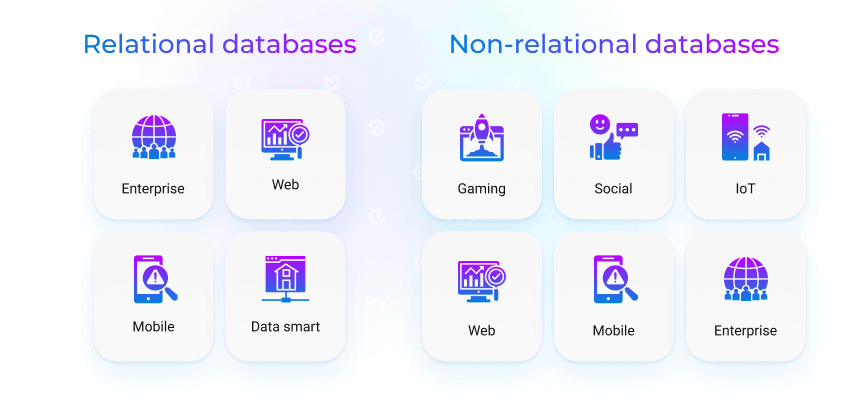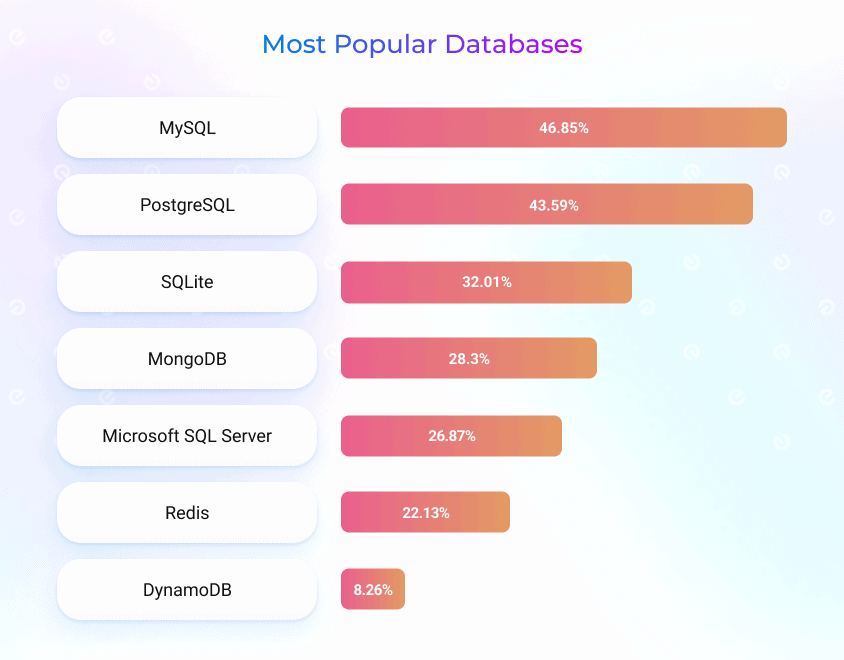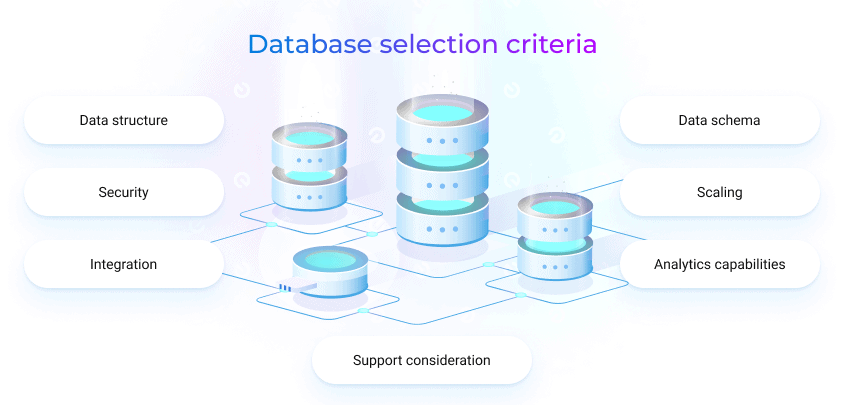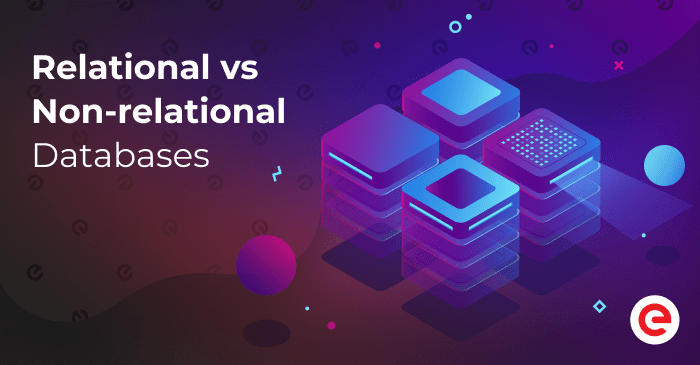
Updated: August 15, 2024
Published: October 4, 2022
How do you approach data processing within your organization? What aspects are worth special consideration? Find the difference between relational vs non-relational databases to make informed decisions and learn how to choose a database regarding your project needs.
List of the Content
- What are databases used for?
- What is relational vs non-relational database?
- Relational vs non-relational database pros and cons
- When to use relational vs non-relational databases?
- Popular databases
- How to choose a database?
- Conclusion
WHAT ARE DATABASES USED FOR?
Having some understanding of the market state and tendencies, there is no chance of underestimating the importance of data. Though to gain some meaningful insights, the data requires processing. It has become an inevitable part of making decisions regarding most business areas. Efficient data processing enables gaining valuable insights to support meaningful decision-making.
The databases are meant to enhance data processes and streamline business operations. They help to increase the value of data assets and eliminate time-consuming and repetitive tasks. Gathering and arranging data can be completed differently, mainly based on the usage and the chosen structure. However, the primary purpose of using a database is pretty straightforward. It enables businesses to collect and run data more efficiently.
So what is exactly a database?
A database is a set of connected data arranged in a way to be stored, accessed, and changed at any time.
Databases are reported to be the backbone of any application, business software, analytics or transactional system. None of these solutions could function without being powered by a database. A good database guarantees effective data integration, reliable data access and consistency, better decision-making, improved productivity, etc.
As for business specifications, databases are used just about everywhere. They are introduced to embrace a broad spectrum of business tasks to be addressed.
- eCommerce businesses greatly depend on processing data on customers, products and services, sales, etc.
- Banking systems handle large sets of data related to transactions, bank accounts, and clients.
- Healthcare solutions won’t function without secure data of patients’ records, clinical documents, healthcare protocols, and treatment guidelines.
- Manufacturing enterprises deal with data regarding supply chains, storage, product lines, etc.
- Social media processes data to increase brand awareness, build good customer relationships and optimize marketing spending.
These are just a few examples of how data is inevitable for businesses of any specification. Therefore, each software solution is powered by a database. Using a database allows teams to gain advantages and reach common business goals.
- Data consistency – The proper database supports the same view of data across the entire organization, including changes made by different users. It improves data accuracy and eliminates inconsistency.
- Enhanced data management – Organizing the streamlined process of collecting, organizing and maintaining data becomes much easier, faster and more secure with the usage of databases.
- Better data security – It becomes simpler to employ protective measures and follow compliance regulations. Databases are good for securing data and preserving its integrity and confidentiality.
- Improved data sharing – The main advantage of data sharing is encouraging better connection and communication between involved parties. The well-managed access promotes the integrated view of data through all business processes.
- Data analysis – The obvious benefit is that data can be turned into a valuable source to improve business operations and support decision-making. Also, it allows teams to focus on data quality, optimize performance, and introduce necessary changes.
- Increased productivity – Combining data with different tools for quality processing results in increased productivity. It eliminates the need to process data manually, thus spending more time on strategic and high-value initiatives.
If the team looks for at least one of these exciting possibilities, they need to find a way to choose a suitable database. At first sight, it might seem complicated. The market offers a wide range of solutions, where teams have to discover the best one regarding their project-specific needs. In order to simplify the process of making this choice, let’s discover the main database types and find the core difference between relational vs non-relational databases.
WHAT IS RELATIONAL VS NON-RELATIONAL DATABASE?
That’s obviously the first question to address when choosing a database for your project. Knowing the difference between relational vs non-relational databases helps to be more specific with your requirements and leverage the right solutions.
Being in use for decades, databases have gone through lots of changes and advancements. But at the same time, most representatives can be referred to as one or another type. Every team commonly faces the choice between the non-relational vs relational database. Let’s cover the major characteristics of each solution to make more informed decisions. And, of course, we’ll start the comparison of relational vs non-relational databases with definitions.
- Relational databases are used to store data in a structured table-based manner. All the data remains easily accessible, linked and related to support relations.
- Non-relational databases work in a completely different way to store semi-structured data. They don’t apply a rigid structure, thus introducing more dynamic schemas for unstructured data processing.
Explained as simply as possible, databases are diversified by data structures. Relational solutions focus on predefined schemas to define and manipulate data. In comparison, non-relational ones are known for better flexibility as they can process any type of data without modifying the architecture.
The distinct characteristic of a relational database is that it always stores data in tables using rows and columns. Therefore, it supports a straightforward and intuitive way of displaying data. At the same time, it allows teams to form relations based on specific entities. Most relational databases use Structured Query Language; thus, they are often called SQL databases.
Non-relational databases are believed to appear as a viable alternative as not all the data can be stored in tabular format. This type embraces all the database types that can’t follow the relational structure and traditional SQL syntax. It doesn’t mean they don’t apply SQL language. What’s more, most of them use both SQL and UnQL (Unstructured Query Language). Therefore this type can also be referred to as NoSQL (not only SQL) databases.
If SQL databases fall under the table-based category, NoSQL databases can be divided into several categories. The most common types of NoSQL databases include:
- Document databases collect, process and retrieve data as JSON-like documents.
- Key-value stores arrange data in a key-value format where keys serve as unique identifiers.
- Graph databases are single-purpose platforms to create and manipulate graphs where data is presented in the form of nodes, edges and properties.
- Wide-column stores organize data into flexible columns to be spread across database nodes and multiple servers. It supports varying the column format regardless of the row in the same table.
Regarding differences between relational vs non-relational databases, teams have gained the opportunity to find reasonable solutions to their needs. Today’s businesses collect and process a huge amount of data, including dealing with complex queries. Well-outlined project requirements establish the foundation for making informed decisions.
The main idea is that they need to choose a database that can query data efficiently and supports instant outcomes. If the project leverages structured data and follows ACID compliance, relational databases are a good choice. If the data remains unstructured and doesn’t fit the predefined criteria, it’s better to choose a non-relational database. So let’s proceed with other essential details that become decisive for the final choice.
RELATIONAL VS NON-RELATIONAL DATABASE PROS AND CONS
Discussing the difference between relational vs non-relational databases, we’d like to draw attention to the main advantages and disadvantages of these database types. It greatly helps teams to make a choice and select a database compatible with set requirements. The main idea is that it allows them to do comprehensive research and remain business-specific. The database selection might be difficult at first sight but considering more details aims to simplify the final decision. So let’s go with the mentioned types of databases to find their pros and cons.
Advantages of relational databases
ACID compliance – ACID properties differentiate a relational database and bring it to the dominant market position. It embraces all the necessary standards to guarantee the reliability of transactions within a database.
Simplicity – Due to the predefined schema and simple structure, the relational database is quite a straightforward solution. It doesn’t require lots of architectural efforts as the team uses structured query language.
Data accuracy – Compared to other database types, the accuracy of data is higher for relational databases. It focuses on preventing data redundancy as there is no repeated or duplicated information.
Security – The table-based model makes it easier to restrict access to confidential data and reduces the chances of errors significantly.
Disadvantages of relational databases
Scalability – Being vertically scalable, the relational database has a distinct disadvantage: low scalability. Strict consistency requirements restrict horizontal scaling, whereas vertical scaling comes with certain limits and greatly depends on supported hardware.
Flexibility – Rigid schemas and constraints could become pros and cons at the same time.
Though it’s easy to interpret the data and identify the relationships, it remains complex to implement changes to the data structure. Relational databases aren’t suitable for huge or unstructured data.
Performance – The relational database performance is tightly dependent on the amount of data, the complexity of tables and its number. Any increase in these areas leads to a time increase in performing queries.
Advantages of non-relational databases
Horizontal scaling – Handling large datasets became easier with the introduction of non-relational databases. Moreover, horizontal scaling allows a team to accommodate, manage and store more data through maintaining lower costs.
Flexibility – With the flexible data schema and non-rigid structure, non-relational databases can combine, process and store any type of data. It becomes a distinct feature that differentiates it from a relational database that handles only structured data. Non-relational databases apply dynamic schemas for unstructured data.
Fast queries – If relational databases can be used for complex queries, queries in non-relational databases remain faster. The main advantage is that it embraces the way to store the data initially optimized for queries. Besides, queries don’t require joints typical for relational database types.
Easier maintenance – Non-relational databases are simpler and faster to set up and maintain. Some of them allow developers to map the data structure similar to programming languages. Thus it supports faster development time and fewer errors.
Disadvantages of non-relational databases
Data integrity – Maintaining data integrity greatly depends on building relationships between data elements. Lack of integrity methods in non-relational databases could reduce overall data reliability, accuracy, and completeness. It becomes the developers’ responsibility to complete accurate and error-free data transferring from one stage to another.
Consistency – Focusing on scalability and performance, the non-relational database opts for consistency issues. It has no required mechanisms to prevent data redundancy and relies on eventual consistency. Thus they aren’t that efficient for handling large amounts of data. Moreover, when database categories vary, achieving all the use cases with one database is hard.
Data analysis – In the light of comparing relational vs non-relational databases, the second ones have fewer facilities for data analysis. Besides, it usually requires programming expertise to handle the analysis, even for the simplest query. Also, many of them lack integration with popular BI tools.
Look for a team of experts to set up a database?
Existek is at your assistance. We provide full-cycle software development services to address your needs and deliver the best market solutions.
WHEN TO USE RELATIONAL VS NON-RELATIONAL DATABASES?
In the light of comparing relational vs non-relational databases, it’s important to address the common use cases. Learning the good market practices and the experience of others can provide some additional insights on how to choose a database for your project. Obviously, one or another category often suits certain needs and requirements better. The team’s task remains to learn details, referring to the smallest details.
At the same time, you won’t find a strict distinction on use cases. Different types of databases were successfully implemented for various types of projects. It’s worth saying that knowing relational vs non-relational database pros and cons is a must-have there. The informed choice can be supported via the detailed analysis of project specifications and solution availability. So let’s check on some useful advice on where to use relational vs non-relational databases.
Use cases of a relational database
- Highly structured data – A stable data structure becomes necessary unless the project entails constant changes. It’s a great option to leverage strict, planned, predictable schemas to handle data distributed across different tables. Besides, it increases access to more tools for testing and analyzing data. The organized and specific nature enables easier manipulation and data querying.
- Secure and consistent environment – When security and consistency are top priorities, teams need to make the right decisions. Relational databases have become a reasonable solution here. ACID principles support all the necessary functionality to handle data due to the latest compliance regulations. This type is an often choice for healthcare, fintech, enterprises, etc.
- Support – Wide support availability is explained by the amount of time on the market. It’s often faster to find the team with the required expertise, as most relational databases follow similar principles. Also, they are more efficient for integrating data from other systems and using additional tools. The team has more product choices when utilizing these types of databases, including business intelligence tools.
Use cases of a non-relational database
- Large amounts of unstructured data – One of the main reasons to apply a non-relational database is that not all data can fit into plain tables. For example, the project needs an efficient tool to accommodate various types of data like videos, articles, or social media content. Therefore, lots of data remain unstructured though it supports horizontal scalability. It helps to cover diversity and bring proper changes if required.
- Flexible development environment – Fast accumulation rates are explained by the ability to collect data quickly and easily without its predefinition. The data often remains not restricted to certain formats and can be processed later. For many teams, a non-relational database is a great option, especially when the project requirements aren’t completely clear or they plan on continuous changes or updates.
- Timing priorities – The fast development environment enables faster and easier product delivery. Less methodical approaches eliminate any upfront preparing, planning, preparing, or designing of the non-relational databases. Teams can proceed with immediate development instead. It commonly suits the needs of MVP or some urgent product releases.
Thanks to the many different database types on the market, there is always a suitable approach to fulfill project needs. Of course, the database selection varies from project to project. Moreover, some teams find it efficient to combine several databases to cover all the use cases.
POPULAR DATABASES: THE CURRENT MARKET STATE
The question of how to choose a database can’t be fully addressed without checking the market availability. It’s a fact that database selection is also impacted by the market state and popularity of certain databases. Besides, the successful experience of others can become a good practice to follow. As long as the team defines project specifications, they are ready to proceed with learning more details on available databases on the market.
Keeping up with market tendencies allows them to stay up-to-date and increase the efficiency of leveraged solutions. The fast growth of the market has brought a great variety of databases to adopt. At present, the number of available databases has reached more than 300 databases. So, in the same way we can diversify databases by types or functionalities, it’s common practice to rank them by popularity.
As we proceed with comparing relational vs non-relational databases, it’s worth saying that representatives of both database types have gained strong positions. Based on the latest Stack Overflow Developer Survey results, let’s look at the most popular databases.
Popular relational databases
MySQL is one of the most known relational databases. Released back in 1995, it has gained considerable popularity due to its functionality and used approaches. The open-source database has great support and is compatible with most libraries and frameworks. It is suitable for delivering cross-platform solutions, and even though mostly used for SQL queries, it also has NoSQL support if required.
PostgreSQL is another powerful open-source object-relational database firstly released in 1996. One of the distinctive characteristics is that it presents data in the form of objects instead of rows and columns. PostgreSQL is highly extensible; thus, it suits the needs of large software solutions. There’s no need to recompile the database as developers can write the code in various programming languages.
SQLite is also a relational database management system released in 2000. It obtains one distinctive difference since it’s a server-side database. That often makes it faster as requests are serialized by the server. Also, it has bindings to different programming languages and is used for a variety of solutions, including IoT and embedded systems.
Microsoft SQL Server is a known relational database management system introduced by Microsoft in 1989. They have greatly improved the solution with many unique features like customization, in-memory analytics, integrations, etc. Also, it supports different development tools and cloud services; however, it only works on Windows-based servers.
Popular non-relational databases
MongoDB is classified as a non-relational solution, particularly a document-oriented database released in 2009. It enables storing different types of data as it uses JSON-like objects. This technology solution works way faster than relational ones because it doesn’t require processing collected data. It usually remains unstructured and is suitable for handling massive sets of data.
Redis is a popular in-memory data store that is also used as a key-value database introduced in 2009. This open-source non-relational solution embraces in-memory data structure to support extensibility and clustering. It allows teams to store large data sets without a complex structure. Redis is often combined to leverage other data storage solutions as it can be applied as a caching layer.
DynamoDB is a non-relational database introduced by Amazon in 2012. The tech focus embraces the support of data structures, documents and key-value cloud services. High scalability and performance remain the main advantages of choosing this database as it enables running high-performance apps at any scale.
Due to the good functionality and being first to the market, the relational solutions still gain a considerable share of the market. Indeed, the introduction of new representatives makes everyone strengthen available approaches and keep on advancing new solutions.
How to choose a database for your project?
Get a professional consultation with Existek experts to define your functional and non-functional requirements to make a reasonable database choice.
HOW TO CHOOSE A DATABASE: RELATIONAL VS NON-RELATIONAL DATABASES
Gathering all the vital details on different types of databases becomes necessary for making a good choice. With well-defined project requirements, the team looks for a database to correspond to their needs and support solution efficiency. The important thing is that both database types are viable options. The awareness of major differences greatly helps with its selection.
| Databases | Relational | Non-relational |
| Language | Structured Query Language (SQL) | Structured Query Language (SQL), Unstructured Query Language (UnQL) |
| Data schema | Predefined schemas | Dynamic schemas |
| Database categories | Table-based | Document, key-value, graph, and wide-column stores |
| Scalability | Vertical scalability | Horizontal scalability |
| Performance | Low | High |
| Security | High | Less secure |
| Complex queries | Used | Not used |
| Base properties | ACID (atomicity, consistency, isolation, durability) transaction supported | Follows CAP (consistency, availability, partition tolerance) theorem |
| Online Processing | Used for OLTP | Used for OLAP |
| Hierarchical data storage | Not suitable | Best suitable |
| Usage | Better for multi-row transactions | Better for unstructured data like documents or JSON |
There isn’t a bad choice; it’s more about the opportunity to meet requirements better and receive more outcomes. Considering the abovementioned aspects, we’ve also decided to focus on key aspects on how to choose a database.
Data schema
The main difference between the non-relational vs relational databases remains the applied data schemas. If relational solutions use predefined schemas and deal with structured data, non-relational ones apply flexible schemas to process unstructured data in various ways. It’s important to remember that this factor often explains other distinct specifications of the database selection.
Data structure
Structuring supports the way to locate and access data. If the team chooses the relational architecture, they proceed with the table-based structure. The tabular format focus on linking and relating based on common data. The non-relational solutions can differ by several structures, including key-value, document, graph or wide-column stores. In other words, they bring alternatives to structure data impossible to deal with in relational databases.
Scaling
The database selection can also be impacted by properties to scale your non-relation vs relational database. The relational database is vertically scalable when the load increase should be completed on a single server. Non-relational solutions are proven more efficient here as horizontal scaling allows adding more servers, thus handling higher traffic.
Security
It has always been crucial to leverage well-protected and highly secured solutions. ACID compliance for relational databases makes them more secure and easier to restrict access to confidential data. Non-relational types of databases are considered less secure, though known for great performance and scalability.
Analytics capabilities
Relational databases are considered more efficient for leveraging data analysis and reporting. Most BI tools won’t let you query non-relational databases but work great with structured data. Of course, it is important to check the current database’s functionality as many of them keep introducing new alternatives.
Integration
Another aspect to consider in choosing a relational database vs a non-relational database is the opportunity to integrate it with other tools and services. Teams always have to check its compatibility with other tech solutions applied to the project. Integration requirements are growing dramatically to support consistency across all business solutions.
Support consideration
Let’s draw attention to the point of how each representative is supported. It involves constant database advancement and its popularity on the market. Lack of support always ends with unexpected results and often failures. Make sure to choose databases that have gained good market share, have strong community support and meet the project needs.
Obviously, the database selection varies from project to project, but the main thing it should correspond to outlined needs. There won’t be a bad choice as every project can be addressed from different perspectives. The main idea is to choose a database that can bring efficiency and meet the outlined project-specific requirements.
CONCLUSION
An excellent way to compare relational vs non-relational databases relies on a comprehensive analysis of its core aspects, main pros and cons and typical use cases. Considering all the gathered details in this article, we can conclude that relational databases are a good choice when teams look for dynamic queries, high security and cross-platform support. If scalability, performance, and flexibility remain the main priorities, it is better to opt for non-relational databases.
Have additional questions on how to choose a database?
Feel free to contact our team. Existek is a professional software development company with extensive expertise in delivering valuable solutions primarily focusing on our client’s needs.
Frequently asked questions
What are databases used for?
Databases are used for collecting, processing and accessing different types of data. The main purpose of database adoption is to make data easily accessible for later use. They help to ensure data accuracy and reliability, control access and avoid redundancy. The database is a powerful engine required to implement any software solution.
What is the difference between relational vs non-relational databases?
Data storage patterns and access characteristics are core aspects to differentiate main database types. Relational databases embrace strict schemas that work for structured data only. Non-relational databases are known for dynamic schemas suitable for unstructured data processing.
What are database selection criteria?
There isn't one database to fit all needs. But every team has a chance to find a reasonable solution after careful analysis and consideration of relational vs non-relational databases. The decisive criteria include data schema and structure, scaling, security, performance, integration, analytics capabilities and support consideration.
What are popular databases?
The market has a wide range of solutions to address the increasing demand. Following good market practices, teams won't find it difficult to make a reasonable choice and meet the project's needs. As for current tendencies, the most market share is held by such representatives as:
Relational databases: MySQL, PostgreSQL, SQLite, Microsoft SQL Server
Non-relational databases: MongoDB, Redis, DynamoDB

